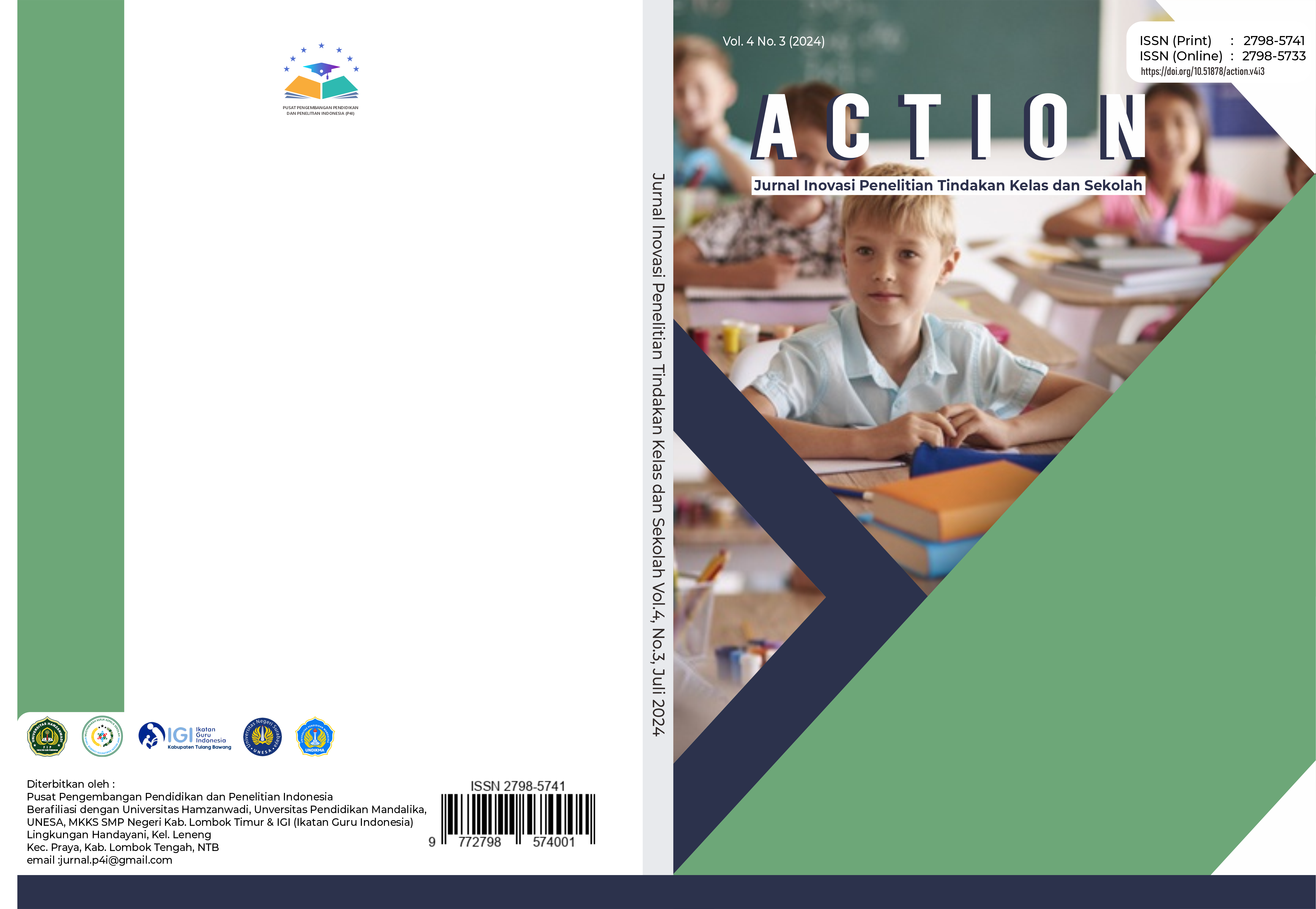PENDEKATAN CULTURALLY RESPONSIVE TEACHING (CRT): SOLUSI MENINGKATKAN PEMAHAMAN BANGUN RUANG SISWA KELAS V
DOI:
https://doi.org/10.51878/action.v5i2.4994Keywords:
hasil belajar, bangun ruang, Culturally Responsive Teaching, matematika dasar, penelitian tindakan kelasAbstract
The learning outcomes for the topic of three-dimensional shapes in Grade V at SPF SDN 101789 Marindal I remain relatively low, as evidenced by the limited number of students achieving mastery when the learning process was still dominated by the lecture method. This condition reflects a mismatch between the expected learning objectives and the actual situation in the classroom. Therefore, this study aims to improve student learning outcomes through the implementation of the Culturally Responsive Teaching (CRT) approach, a teaching strategy that connects lesson content with students' cultural backgrounds and personal experiences.This study employed classroom action research (CAR) conducted in two cycles, each consisting of four stages: planning, action implementation, observation, and reflection. Data were collected through achievement tests to assess students' learning outcomes and observation sheets to evaluate student activity during the learning process.The research findings revealed that in the pre-cycle stage, only 3 out of 18 students (16.67%) achieved the Minimum Mastery Criteria (MMC) with an average score of 46.11. In the first cycle, the number of students who met the criteria increased to 5 (27.78%) with an average score of 61.67. A more significant improvement occurred in the second cycle, where 12 students (66.67%) reached the MMC and the average score rose to 72.22. Based on the results, it can be concluded that the implementation of the Culturally Responsive Teaching approach significantly improved student learning outcomes on the topic of three-dimensional shapes, while also promoting active student engagement in learning activities connected to their cultural backgrounds
ABSTRAK
Pembelajaran materi bangun ruang di kelas V SPF SDN 101789 Marindal I menunjukkan hasil belajar yang masih rendah, terlihat dari minimnya jumlah siswa yang mencapai tingkat ketuntasan saat proses pembelajaran masih didominasi oleh metode ceramah. Kondisi tersebut mencerminkan adanya ketidaksesuaian antara tujuan pembelajaran yang diharapkan dengan situasi nyata di dalam kelas. Oleh karena itu, penelitian ini bertujuan untuk meningkatkan hasil belajar siswa melalui penerapan pendekatan Culturally Responsive Teaching (CRT), yaitu strategi pembelajaran yang menghubungkan materi ajar dengan budaya serta pengalaman pribadi siswa. Penelitian ini menggunakan metode penelitian tindakan kelas (PTK) yang dilaksanakan dalam dua siklus, masing-masing mencakup empat tahap, yakni perencanaan, pelaksanaan tindakan, observasi, dan refleksi. Data dikumpulkan melalui tes untuk mengukur hasil belajar siswa serta lembar observasi untuk menilai aktivitas siswa selama proses pembelajaran. Temuan penelitian mengungkapkan bahwa pada tahap pra siklus, hanya 3 dari 18 siswa (16,67%) yang berhasil mencapai Kriteria Ketuntasan Minimal (KKM) dengan rata-rata nilai 46,11. Pada siklus I, terjadi peningkatan jumlah siswa yang tuntas menjadi 5 orang (27,78%) dengan rata-rata nilai 61,67. Peningkatan yang lebih signifikan terlihat pada siklus II, di mana 12 siswa (66,67%) mencapai KKM dan rata-rata nilai naik menjadi 72,22. Berdasarkan hasil penelitian, dapat disimpulkan bahwa penerapan pendekatan Culturally Responsive Teaching secara signifikan mampu meningkatkan hasil belajar siswa pada materi bangun ruang, sekaligus mendorong partisipasi aktif siswa dalam pembelajaran yang terhubung dengan latar belakang budaya mereka.
Downloads
References
Adjie, N., Putri, S. U., & Dewi, F. (2021). Improvement of Basic Math Skills Through Realistic Mathematics Education (RME) in Early Childhood. Jurnal Obsesi?: Jurnal Pendidikan Anak Usia Dini, 6(3). https://doi.org/10.31004/obsesi.v6i3.1832
Aguirre, J., Mayfield-Ingram, K., & Martin, D. B. (2013). What Mathematics? For Whom? For What Purposes? The Impact of Identity in K-8 Mathematics: Rethinking Equity-Based Practices.
Agung Subagyo. (2015). Pengenalan Rumus Bangun Ruang Matematika Berbasis Augmented Reality. Prosiding SNATIF, 2(2).
Hammond, Z. (2015). Culturally responsive teaching and the brain: Promoting authentic engagement and rigor among culturally and linguistically diverse students. In Culturally responsive teaching and the brain: Promoting authentic engagement and rigor among culturally and linguistically diverse students.
Ladson-Billings, G. (2014). Culturally relevant pedagogy 2.0: A.k.a. The remix. In Harvard Educational Review (Vol. 84, Issue 1). https://doi.org/10.17763/haer.84.1.p2rj131485484751
McQueen, R. (2022). Enhancing student agency in the primary music classroom through culturally responsive practice. Teachers and Curriculum, 22(2). https://doi.org/10.15663/tandc.v22i2.403
Prihantoro, A. (2021). Asesmen Formatif Pada Pendidikan Anak Usia Dini Di Indonesia. As-Sibyan: Jurnal Pendidikan Anak Usia Dini, 6(1). https://doi.org/10.32678/as-sibyan.v6i1.3955
Schirmer, B. R., & Lockman, A. S. (2022). Culturally Responsive Teaching in an Undergraduate Online General Education Course. Online Learning Journal, 26(3). https://doi.org/10.24059/olj.v26i3.2805
Siwatu, K. O. (2007). Preservice teachers’ culturally responsive teaching self-efficacy and outcome expectancy beliefs. Teaching and Teacher Education, 23(7). https://doi.org/10.1016/j.tate.2006.07.011
Snyder, H. (2019). Literature review as a research methodology: An overview and guidelines. Journal of Business Research, 104. https://doi.org/10.1016/j.jbusres.2019.07.039
Xu, W. (2024). When East meets West: A practitioner inquiry of culturally responsive pedagogy in an Australian Chinese as a Foreign Language classroom. International Journal of Applied Linguistics (United Kingdom), 34(1). https://doi.org/10.1111/ijal.12487
Yunanda Pradiani, N. P. W., Turmuzi, M., & Fauzi, A. (2023). Pengembangan Media Pembelajaran Pop-Up Book Materi Bangun Ruang Pada Muatan Pembelajaran Matematika Kelas V Sekolah Dasar. Jurnal Ilmiah Profesi Pendidikan, 8(3). https://doi.org/10.29303/jipp.v8i3.1503
Zhou, C. (2024). Children’s cognitive abilities in the context of the digital transformation of basic education. Interactive Learning Environments, 32(1). https://doi.org/10.1080/10494820.2022.2081208
Downloads
Published
How to Cite
Issue
Section
License
Copyright (c) 2025 Wardini Wardini, Herdi Ramon, Mimi Rosadi, Yuliana Indah Sari Sitio

This work is licensed under a Creative Commons Attribution-NonCommercial-ShareAlike 4.0 International License.















